THE HOLY ROYAL MARTYRS
IN THE LIGHT OF HISTORY AND GOD’S PROVIDENCE
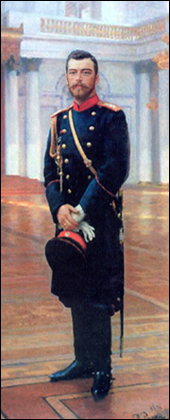
Behind all wars, revolution, downfall of kingdoms, – all the political events of external history – we see the hidden working of spiritual laws and, in the final analysis, God’s Providence concerning the fates of peoples and nations. Any other explanation of the reasons for the revolutions of 1905 and 1917 would be incomprehensible and inaccurate. One thing is certain: the Russian society’s apostasy from God and the Church brought down God’s wrath upon Russia. As in the many cases of ancient Israel’s apostasy from God, about which we read in the Bible, Russia’s malady could not be cured by ordinary measures. For the sake of instruction and correction God would hand the Jews over into the hands of infidels; the very same fate befell Russia in the beginning of the 20th century.
Through Tsar Nicholas II – an irreproachably pure and wonderful person – God’s will was made manifest in the world. His fate, in essence, was deeply tragic. He was born on the day of St. Job the Much-suffering and was keenly aware that his life was similar to Job’s martyric path. His knowledge of his fate was truly prophetic. “I have more than a presentiment, – he used to say, – that I am doomed to terrible trials, and that I will not be rewarded for them in this world.” Beginning with Russia’s defeat in the Russo-Japanese war, which was followed by the revolution of 1905-1907, which diminished the Tsar’s power and freed the forces of anarchy and outright evil, the foundations of Russian sovereignty tottered more and more. “I am unsuccessful in all my undertakings, – the Tsar bitterly concluded, – I have no luck. However, man’s will is so powerless anyway.” He realized that he was not subjectively to blame for Russia’s misfortunes; the good of the motherland meant more to him than anything else, and he did everything he could for this good. Tsar Nicholas’s conscience was clear before God, but his moral suffering, nevertheless, reached extraordinary proportions. Thus once, – this was during the first Russian revolution, – from the depths of his inner anguish the Tsar uttered prophetic words which indicated with absolute accuracy the role he was invisibly assigned to play in Russia’s fate by God Himself. “Perhaps a sacrifice is needed for the salvation of Russia, – said the Sovereign. – I shall be that sacrifice. May God’s will be done.” In saying this the Tsar was like the martyrs of ancient times, who freely and without coercion gave themselves up to suffering for Christ. Nicholas II was murdered in July of 1918 not simply as a helpless and defenseless person: the extraordinary courage of his behavior as he descended into the cellar of the Ipatyev house with his sick son in his arms, and even earlier, when he and the Empress refused to emigrate or flee the country, – all this speaks of the fact that their souls were ready for sacrificial and Christ-like suffering, which fulfilled the prophetic words spoken by him 10 years before.
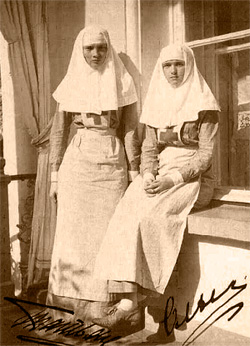
When Austro-Hungary declared war on Serbia, Russia came to the aid of this small Slavic nation. This event still lives in the historic memory of the Serbs; and if among European nations there is still anyone who loves Russia and Russians – it is the Serbs. However, their greatest love was for Tsar Nicholas II, who had sanctioned Russia’s participation in the war. It was the Serbs who began venerating the Russian Tsar as a saint, placing him on a par with their great Saint Savva of Serbia. And it was among the Russians in Serbia that the issue of canonizing the Royal Family was brought up for the first time in 1938.
The beginning of the war brought success to the Russians at the front, and the country was gripped by patriotic fervor. The rear provided immense aid to the front; the Empress and the Princesses took an active part in it. After learning the art of nursing, they daily spent many hours in the hospitals. The Empress and her daughters Olga and Tatyana tended the wounded and sat with the dying, providing great comfort to the sufferers. The Empress and Tatyana also worked as surgical nurses; it is not hard to imagine their courage, patience, and truly Christian love: assisting the doctors in numerous amputations of injured limbs required, besides training, great moral strength. The Winter Palace was also turned into a huge hospital. This enterprise also included the preparation of undergarments, warm clothes, and other items needed by the soldiers at the front; the entire work was organized by the Empress. She also sent to the front a multitude of Gospels, icons, and crosses, which were handed out to the soldiers. One can imagine the joy of a soldier who had received such a blessing from the Empress!
Soon, however, our armies’ offensive stopped, while our losses began to increase. Discontent arose in the top circles of society – both in the capital and at military headquarters. The revolutionaries made use of the lack of success at the front, in order to disseminate their propaganda at the front and in the rear. The Germans quickly moved toward the heart of Russia; in these conditions, wishing to raise the spirit of the troops, the Tsar took upon himself the supreme command and moved to General Headquarters, deployed at Mogilev. Prince Alexis went with him to the front.
However, making use of the Tsar’s absence from the capital, oppositional aristocracy increased its activity. The court discussed the advisability of a coup- d’etat, placing Grand Duke Nicholas (the Tsar’s uncle) on the throne. The opposing faction asserted that the Tsar and the Empress stood in the way of Russia’s victory in the war; Grand Duke Nicholas sent the Tsar a telegram, entreating him to abdicate the throne. Similar telegrams were also sent by the majority of the commanding officers at the front. And when a revolution occurred in February 1917, the Tsar’s entourage took the side of the provisional government. The Tsar was assured that only his abdication from the throne could save Russia. And in the face of such betrayal the Tsar sacrificed himself, heeding these voices. After a fervent prayer during the night in front of an icon, he abdicated the throne; this took place on March 2nd. “There is no sacrifice that I would not make for the true good and salvation of Russia. For this reason I am ready to abdicate the throne” – such is the telegram he sent to the chairman of the Duma.
However, after the abdication everything turned out contrary to what the opposition was expecting: the people began to fall prey to their basest passions and moral decay set in; with unbridled speed Russia rushed towards destruction. The Tsar’s sacrifice was accepted by God, but not in the way that the architects of the abdication had in mind: there was no immediate outward benefit from it. The Tsar had been that mystic principle which had restrained the forces of evil; now nothing prevented anti-Christian elements from entering into the world.
A new era began for the Sovereign and his family: their worldly life ended and their saints’ life began, together with their Christian endeavors. The Tsar and his entourage were kept under guard at Tsarskoye Selo. The prisoners pinned their hopes only on God’s will, and the Lord helped them retain their inner peace until the very end. The Tsar and his family were subjected to humiliation and mockery from the guards and the other “new” people who now surrounded them. On July 31st the martyrs’ path to Golgotha began: they were taken from their palace and sent on to Siberia.
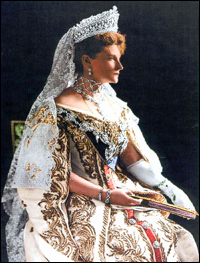
On August 6th the Royal Family arrived in Tobolsk on the ship “Rus’.” “My heart bleeds inexpressibly for the dear homeland,” – these words of the Empress in a private letter describe the inner state of the entire family. But its members were cheerful: they were fortified by their faith, the Church, and God’s grace. They faithfully participated in church services; the Empress and the children sang in the choir. Through their suffering the Royal Martyrs’ spirit grew stronger. “God’s way is a daily cross,” – the Empress wrote these words of St. Isaac the Syrian in her notebook. “Christians must undergo sorrows and external and internal warfare, in order to conquer these blows through patience. Such is the path of Christianity,” – another of her excerpts (from St. Mark the Great) reveals to us the inner state of the sufferers.
On the eve of Pascha of 1918 the Royal Family was parted. A commissar arrived from the Bolsheviks in Moscow and announced to the Tsar that he would be taken away. The Empress decided to accompany her husband despite great inner agony, since she was thus being forced to part from the sick Prince Alexis. Princess Maria went together with her parents…This parting was a torment for the entire family.
The royal couple was detained by the Bolsheviks in Yekaterinburg. In early May the other members of the family came here, together with several loyal servants. The martyrs had two and a half months to live. They were tormented with increasing subtlety, but even among the brutal guards there were those who bowed down before their Christian meekness and humility.
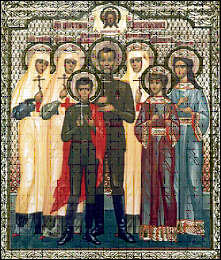
During the night of July 17th the greatest crime was committed: innocent, holy people, together with God’s anointed, were heinously murdered. Three days before this villainy a church service was served for the Royal Family. When the prayer “Grant repose with the saints…” was sung, the martyrs unexpectedly got down on their knees. As though sensing their imminent end, they sang a funereal hymn for themselves… That fatal night the guards came for them, saying that they were being taken out of the city. Instead, they were taken down to the cellar; several chairs were standing there, and the Tsar sat in the middle, holding the Tsarevich in his arms. Together with the Royal Family were Doctor Botkin and their loyal servants. They waited for a sign of departure, but instead a commissar entered the cellar accompanied by soldiers. The commissar – his name was Yurovskiy – announced the forthcoming execution. The Empress only had time to make the sign of the cross; she was killed instantly, at the same time as the Emperor. Prince Alexis and Princess Anastasia suffered longer than the rest; the first bullets did not bring them death, and so the soldiers killed them off with bayonets. The doctor and the three servants died also, sharing the fate of the Royal Family out of love for them. This sacrilegious murder was not simply a private crime of the political revolution: it was a universal sin. The burden of the sin of regicide still continues to lie upon Russia.
Tsar Nicholas II and his family were the carriers of the ideals of Holy Russia, of the ideals of Orthodoxy. In contrast to many people of that era – Christians in name only – they treated Orthodoxy with all seriousness. They were God’s elect and, therefore, people not of this world; they were alien to the society of those times. As true Christians, they were persecuted in this world; their sorrowful path was crowned by martyrdom. Now, together with all the other Russian saints, they stand before Christ in prayer for Russia.

HOMILY FOR THE TRANSFIGURATION OF OUR LORD

The Lord took His beloved disciples Peter, James, and John up Mount Tabor and was transfigured before them – His face became bright like the sun, and His clothing white like snow. Moses and Elias also appeared with the Lord and conversed with Him, and a cloud descended upon the Lord’s disciples, and a voice was heard from heaven: “This is My beloved Son, hear Him.” Peter exultantly (for he knew not what he was saying) asks the Lord that three tabernacles, or tents, be erected: one for the Lord, one for Moses, and one for Elias.
The Transfiguration of the Lord is an image of the Glorious Resurrection of Christ. What is the meaning of this mystical event on Mt. Tabor?
The Transfiguration of the Lord revealed the glory of the Lord before His journey to Golgotha – His glory was revealed to the disciples to strengthen their faith. They saw the glory of the Saviour on Mt. Tabor before they were to see His suffering, His Crucifixion and death.
The everlasting light of Mt. Tabor also enlightens the life of every believing person and it enlightens the life of the whole Church.
Man is weak in this world; upon this earth he is frail. Living in his carnal, corrupt shell, his faith is tested, and his spirit is weakened. But, with God’s help and with His Grace, everyday trials are overcome and man is able to walk upon the path of the cross, upon the path of spiritual life, and the glory of the Transfiguration of the Lord is revealed to him. For being that we are participants in Christ’s sufferings on Golgotha, we are, therefore, also participants in His Transfiguration.
The glory and victory of our spiritual nature is revealed on Mt. Tabor. This spiritual nature of ours will overcome the corruption of our physical nature in the General Resurrection and as a promise of this the Divine Body of the Lord is revealed, being already glorified and enlightened like the sun and snow.
This mystical event affirms our faith in the coming transfiguration of the whole universe and each one of us in the General Resurrection. But this affirmation comes not in the form of a covenant, but in the actual body of the Lord transfigured on Mt. Tabor.
Furthermore, all of this relates to the very life of our Church. If each individual believing soul is weakened and needs confirmation of its faith and spiritual path, then all the more, the entire Holy Church is in need of this, for the Church journeys on the same path which the Saviour walked on earth, it walks the path to Golgotha. For the external trials which trouble the Church and all her many internal sorrows are able to trouble the hearts of men, just as Christ’s sufferings troubled His disciples.
The Transfiguration then reveals a promise of the future glorification and victory of the Church, when our Lord Jesus Christ will come in His glory. However difficult our trials may be, they must all be dissolved in the mystical light of Mt. Tabor. If a faithful person, a member of the Holy, Orthodox, Catholic, and Apostolic Church, is overcome with despondency at the sight of divisions in the Church or the apostasy of separate individuals, or their deviation from the true path of Christ, and is overcome with doubt, thinking that the spirit of Antichrist is creeping into the Church, let the unwaning, mystical light of the Transfiguration embolden him, for the Transfiguration is the promise of the victory of Christ’s Church. Amen.

THE HOLY THEOTOKOS — IMAGE OF AN IDEAL WOMAN
One of the most terrible manifestations of our times is the complete distortion of the image of an ideal woman. The ideal image depicted for us by the mass media shows a sort of attractive witch, unashamedly half-naked, with loose and disheveled hair, impudent glance, business-like, energetic, fearless, unfettered by moral laws or conscience. In consequence, unfortunate young girls and women – mothers, wives, daughters, – striving to imitate this devilish image, corrupt their souls, ruin their families, hopelessly destroy their own and others’ lives.
Yet at the same time we – Orthodox Christians – always have before our eyes the image of the One Who was more beautiful and wondrous than all the people on earth and even all the celestial denizens, the cherubim and the seraphim, the One Whom the Pre-eternal Council chose to become the Mother of God. As St. Dimitry of Rostov says: “After Adam’s transgression the Word of God did not forthwith come down to earth to be incarnated and save fallen mankind,” because “there was not yet a single maiden on earth who was pure not only in body, but also in spirit.” Thus the Theotokos’s major characteristic is Her virginal purity.
Another characteristic of this greatest Handmaiden of God is Her humility. Of all the personages in the Gospel, there is no one about whom we know so little as the Holy Virgin; Her entire life is shrouded in mystery, and yet She was undoubtedly the spiritual center of the first Christian Church after Her Divine Son’s Ascension; however, under the cover of modesty, She preferred to remain in the shadows.
The third characteristic of the Holy Virgin, according to St. Dimitry of Rostov, was Her all-encompassing and boundless love for God, which is mentioned in the following spiritual song: “O Mother-Virgin, miracle of chastity! Thou art daughter of the heavenly Father, the bride of the Holy Spirit, the Mother of Christ – the Son of God.”
There was not a single one among the Holy Fathers who did not laud the Theotokos! Foretold and presaged by the Old Testament prophets, She is glorified by all the ancient and contemporary Holy Fathers of the Orthodox Church.
As St. Gregory of Neocaesaria says, what amazes us in the Holy Virgin is not only Her chaste and pure physical beauty, but above all the beauty of Her soul. She was holy both in body and soul. Her garments were modest, Her gait was dignified, Her speech was brief, pouring out of a humble heart; all Her thoughts and all Her desires were turned only towards God.
The Church historian Nikiforos Kallistos adds: in conversing with others She retained Her modesty, did not laugh immoderately, did not express indignation, did not argue, never thought of Herself, and was characterized by total humbleness.
More than anything else in the world She loved Her Son, loved Him so much that She was ready to die with Him, yet with what courage and firmness She accompanied Him when He went on His path of suffering, was present at Golgotha when He was being crucified, stood at His Cross and attended His burial. “She wears the crown of martyrs, – says Leo the Philosopher, – because as She stood at the Cross, with Her soul pierced by the greatest anguish, She suffered more than all the martyrs.”
She loved and respected Her family members, but also loved and welcomed all strangers. St. Ambrose of Milan says: “She never offended anyone, never denigrated anyone, even the poorest person. Her modest belongings, consisting of two robes, She gave away before Her death to the two widows who served Her.”
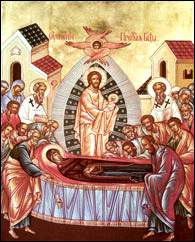
Each person’s death sums up his life and brings recompense from the Lord – either reward or punishment. The most-glorious Dormition of the Mother of God revealed Her in all Her majesty and glory. Three days before Her death the Archangel Gabriel appeared before Her, announced Her repose and gave Her a shining branch from paradise – symbol of victory over death and corruption. On the third day after Her Dormition, the Mother of God appeared to the apostles in indescribable glory, surrounded by a multitude of angels, and said: “Rejoice, I am with you forever.” The apostles, filled with joy, instead of saying their usual “O Lord Jesus Christ, help us!”, exclaimed: “O Holy Mother of God, help us!”
And thus all Christians pray to the Holy Mother of God to help them. Help us then, O Most Holy Theotokos, grant our children the enlightenment to see in Thee the purest and most beautiful example of behavior, save and protect them from the vices and temptations of these evil times!
(Reprinted from “Orthodox Russia,” No. 16, 2003.)

HOMILY FOR THE FEAST OF THE GREAT-MARTYR PANTELEIMON
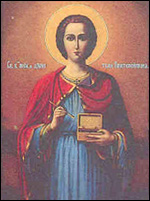
In ancient times, when referring to martyrs, they were called “witnesses,” in accordance with what the Lord Jesus Christ told the apostles about their future service: “You shall be My witnesses everywhere.” In truth, what testimony can be greater than when a person is ready to seal it with his blood and life, as did the holy martyrs. Those around them could not but wonder at the strength exhibited by the martyrs who, with all possible benefits spread before them, turned away from them and chose torture and agonizing death instead. They were aided by a special sort of force, and their hearts were touched by genuine truth.
For example, look at the great-martyr Panteleimon – a wealthy, prominent, and handsome young man, before whom an entire life was spread out, and the way was open to the best possible circumstances from a human point of view. And yet what did he choose? An agonizing death. We know that prior to his baptism he was not called Panteleimon, which was the name he received at baptism, but was called Pantoleon. This Greek name consisted of two words that meant “strong in all things.” The name characterized his strong and forceful nature. However, when he was illuminated by the light of baptism through the offices of the holy martyric presbyter Hermolaus and became a Christian, he was given another name – that of Panteleimon, which means all-merciful or merciful to all. And we know how this holy youth spread healing and all kind of spiritual help around him. But when he was called upon to bear witness to his faith in Christ, he went out to suffer terrible tortures, rejoicing that in this manner he would affirm his loyalty to the One Whom he had come to love with his entire pure heart.
The situation is different in our times. No one threatens us with bloody torture or agonizing death. Yet, on the other hand, our times are such that in order to be a Christian always and in all things, and to act like a Christian in all ways, one also needs a fair amount of spiritual force, for the further we progress, the deeper and deeper and faster and faster does the world roll down the slope into an abyss of materialism and insanity… And the Christian who lives in the nightmare of our times and still wishes to truly be a Christian must naturally have strength of spirit similar to the strength possessed by the ancient martyrs. Saint Panteleimon is precisely one of such witnesses, who stood face-to-face before the pagans and testified to the light of Christ’s truth, to its unfading radiance, to its all-conquering power, for these martyrs truly confirmed the apostolic words: “Such is the victory which conquered the world – our faith!” Amen.

LIVES OF THE SAINTS
Saint John of San Francisco in Shanghai
(From the memoirs of Maria Aleksandrovna Shakhmatova,
matron of St. Tikhon’s Orphanage in Shanghai.)
M.A. Shakhmatova witnessed the saint’s ascetic exploits in Shanghai almost from the very moment of his arrival there in 1934, on the feast of the Entrance of the Theotokos into the Temple. She saw Archbishop John crucify himself in both founding and managing the orphanage. Living conditions were terrible, and the needs of the children, whose parents had escaped Communism, were overwhelming. The young Bishop, almost from the start, gathered concerned ladies from his parish, asked them to found a committee, rented a house, and opened up a hostel for orphans or children whose parents were in need. The children would often be underfed, abused, and frightened, until Archbishop John would come and personally take them into his orphanage and school. Each child – and there were over three thousand who went through the orphanage – had a traumatic story.
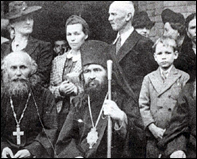
There was, for example, a boy named Paul who had witnessed his father and mother being killed and chopped into pieces by the Communists right in front of his eyes. Because of the trauma the boy had become mute and could not even pronounce his own name. He was like a trapped animal, afraid of everyone, and trusted only his fists and spitting. He was brought into the orphanage at a time when it was packed and had no place for him. Due to the fact that Paul was so frightened, the ladies there thought that he was abnormal and refused to accept him lest he scare the other children. When Archbishop John found out about him, he insisted on immediately dropping everything and going to meet the boy personally. They did not even know that he was a Russian boy and spoke Russian, for he only mumbled and hissed like a caged animal. When Archbishop John arrived, he sat down before the boy, who was still trembling, and said to him the following: “I know that you have lost your father, but now you have found another one – me,” and he hugged him. This was said with such power that the boy burst out in tears and his speech returned to him.
In the slums of Shanghai there were cases in which dogs would devour baby girls who had been thrown into garbage cans. When the newspapers announced this, Archbishop John told Mrs. Shakhmatova to go and buy two bottles of Chinese vodka – at which she cringed in horror. But her horror increased when he demanded that she accompany him into these very slums, where it was common knowledge that grown-up people would be murdered. Fearless as ever, the young Bishop insisted on going there, walking through dark alleys in the worst neighborhood. She recalled what horror seized her heart when they, in the darkness of night, walked and encountered only drunkards, shady characters, and growling dogs and cats. She held the bottles in her hands, following him with trepidation, when suddenly a growl was heard from a drunken man sitting in a dark doorway, and the faint moan of a baby was heard from a nearby garbage can. When the Bishop hastened towards the cry, the drunkard growled in warning. Then the Bishop turned to Mrs. Shakhmatova and said, “Hand me a bottle.” Raising the bottle in one hand and pointing to the garbage can with the other, Blessed John, without words, conveyed the message of the proposed sale. The bottle ended up in the hands of the drunkard, and Mrs. Shakmatova saved the child. That night the Bishop returned to the orphanage with two more babies under his arms. This fearlessness, however, had not been acquired without a deep inner struggle.
Even then he was already known as a miracle-worker, because he prayed for whomever would ask him, and often his prayer would be answered immediately. The Bishop never slept at night, but only dozed off sometimes, sitting in a chair. Once Mrs. Shakhmatova, in the middle of the night, chanced for some reason to climb up into the belfry. The door to it led from the top floor of the vicarage. It was cold and windy. As she opened the door, she saw that Blessed John was in deep, concentrated prayer, freezing, shivering in the open air, wind sweeping through his robe, and that he was blessing the houses of his parishioners from above. She thought, “While the world is asleep, he keeps watch like Habakkuk of old, guarding his flock with his fervent intercession before God, so that no harm can steal his sheep away.” Deeply shaken, she withdrew. Thus she had a clue as to what he was doing during the long winter nights when all the people take their normal rest in their comfortable beds. “Why was it needed?” asked Mrs. Shakhmatova. “Who asked him to do it? Why such self-sacrifice, when his presence was needed everywhere?” And she answered her own question: “He had an unquenchable love for God. He loved God as a Person, as his Father, as his closest Friend. He longed to talk with Him, and God heard him. It was not some conscious self-sacrifice. He just loved God and did not want to be separated from Him.”
“Once during the war,” she continued, “the poverty of the orphanage reached such immense proportions that there was literally nothing with which to feed the children, and there must have been at least ninety of them at that time. Our staff was indignant because Archbishop John kept bringing in new children, some of whom had parents, and we were having to feed someone else’s children. Such were his ways. One evening when he came to us – worn out, tired, cold, and silent – I could not resist telling him off. I said that we women could not tolerate this any longer, that we could not bear to see hungry little mouths and not be able to put anything into them. I could not control myself and raised my voice in indignation. I not only complained, I was full of wrath at him for putting us through this. He looked sadly at me and said, ‘What do you really need?’ I said, right off the bat, ‘Everything, but at least some oatmeal. I have nothing to feed the children with in the morning.”
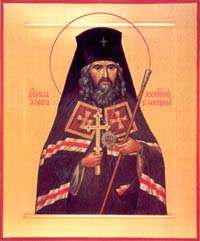
Archbishop John looked at her sadly and went upstairs. Then she heard him making prostrations, so vigorously and loudly that even the neighbors complained. Pangs of conscience bothered her, and that night she couldn’t sleep. She dozed off in the morning, only to be awakened by the doorbell. When she opened the door, there stood a gentleman of English extraction who said that he represented some cereal company, and that he had a surplus of oatmeal; and he wanted to know whether they could use it since he heard that there were children there. They began to bring in bags and bags of oatmeal. While this was going on, with the commotion of banging doors, Blessed John began to descend the staircase. Hardly could Mrs. Shakhmatova utter a word to him when she saw his glance. He did not say anything, but with his eyes, with one single glance, he reproached her for her unbelief. She said she could have fallen on her knees and kissed his feet, but he was already gone to continue his prayer to God, now of thanksgiving.
(Reprinted from “The Orthodox Word)

ORTHODOX VENERATION OF THE MOTHER OF GOD
(Continuation)
IV. The heresy of Nestorius which declared the Mother of God to be only the Mother of Christ, and the 3rd Ecumenical Council.
When even those who dared to speak out against the sanctity and chastity of the Most-holy Virgin Mary were silenced, an attempt was made to destroy the veneration of Her as the Mother of God. In the 5th century, the Archbishop of Constantinople Nestorius began to preach that Mary only gave birth to the man Jesus, in Whom divinity dwelt as in a temple. Nestorius first allowed his priest Anastasius, and later began to openly preach in church himself, that Mary cannot be called the Mother of God, since She did not give birth to the God-man. He considered it degrading for himself to worship an infant wrapped in swaddling clothes and lying in a manger.
These sermons caused general agitation and concern for the purity of the faith, first in Constantinople and then in all the places reached by rumors of the new teaching. Saint Proclus, a disciple of St. John Chrysostome, at that time the Bishop of Kizil and later Archbishop of Constantinople, preached a sermon in church in the presence of Nestorius, in which he confessed the Son of God being incarnate from the Virgin, Who is truly the Mother of God, for already in Her womb the Infant conceived in Her by the Holy Spirit was united with Divinity, and this Infant, although born from the Virgin Mary due to His human nature, was already born as true God and true man.
Nestorius persevered in his obstinacy and refused to change his teaching, saying that one must differentiate between Jesus and the Son of God, that Mary should not be called the Mother of God but rather the Mother of Christ, since the Jesus Who was born of Mary was only a man – the Christ (which means Messiah, the anointed one), similar to the previous anointed of the Lord – the prophets, only surpassing them in the fullness of His contact with God. Nestorius’s teaching thus negated God’s entire blueprint, for if it was only a man who was born from Mary, then it was not God who suffered for us, but a man.
Saint Cyril, Archbishop of Alexandria, hearing of Nestorius’s teaching and the church’s reaction to it in Constantinople, wrote a letter to Nestorius, in which he tried to convince him to keep to the teaching which the Church confessed from its inception and not introduce anything new into it. Moreover, St. Cyril wrote to the clergymen and the faithful of Constantinople, urging them to stand firm in the Orthodox faith and not fear persecution from Nestorius of those who disagreed with him. St. Cyril also informed Pope Celestine in Rome, who at that time stood firm in Orthodoxy together with his flock, about the entire affair.
St. Celestine on his part wrote to Nestorius and urged him to preach the Orthodox faith and not his own. Nestorius remained deaf to all persuasion and replied that what he was preaching was the Orthodox faith, and that his opponents were heretics. St. Cyril wrote to Nestorius again and composed 12 anathemas, i.e. detailed in 12 articles the major differences between the Orthodox teaching and that preached by Nestorius, and excommunicated from the church all those who rejected even a single article.
Nestorius completely rejected all that was written by St. Cyril and detailed his own teaching, also in 12 articles, excommunicating all those who did not accept it. The purity of faith continued to be threatened. St. Cyril wrote letters to the reigning Emperor Theodosius Minor, his wife Eudocia, and his sister Pulcheria, asking them to involve themselves in church affairs and restrain the heresy.
It was decided to convene an Ecumenical Council, at which the hierarchs, assembled from all corners of the earth, would decide whether the faith preached by Nestorius was Orthodox or not. They chose Ephesus as the site for this 3rd Ecumenical Council, because the Most-holy Virgin Mary had once sojourned there with Apostle John the Theologian. St. Cyril assembled his fellow bishops in Egypt, and together with them sailed by ship to Ephesus. Archbishop John of Antioch, together with the Eastern bishops, set out from Antioch by land. The Roman bishop St. Celestine was unable to travel and asked St. Cyril to defend the Orthodox faith and, moreover, he sent two bishops and clergyman Philip from the Roman church on his behalf, instructing them in what to say. Nestorius and the bishops of the Constantinople district, and the bishops of Palestine, Asia Minor, and Cyprus also arrived in Ephesus.

On June 22, A.D. 431, the bishops assembled in the Ephesian church of the Virgin Mary, headed by Bishop Cyril of Alexandria and Bishop Memnon of Ephesus, and took their places. A Gospel was placed in the middle of the church as a symbol that Christ Himself was invisibly presiding over the Ecumenical Council. First of all the Creed composed by the 1st and 2nd Ecumenical Councils was read, and then the participants began reading the documents, going over the prior epistles of Cyril and Celestine to Nestorius and Nestorius’s answers to them. The Council deemed Nestorius’s teaching to be iniquitous and condemned it, depriving Nestorius of his cathedra and his clerical status. Thus the Council’s resolution clearly expressed its belief that Christ, born of the Virgin, is the true God incarnate, and since Mary gave birth to a perfect man Who at the same time was perfect God, She should rightly be venerated as the Mother of God.
After the end of the session the Council’s resolution was immediately announced to the expectant populace. All of Ephesus rejoiced, learning of the defense of the veneration of the Holy Virgin, Who was especially honored in this city whose resident She had been during Her life on earth and whose intercessor She had become after Her entry into eternal life. Joyous glorification of the Holy Virgin and laudation of the Fathers who had defended Her name from heretics were heard everywhere.
The Council had 5 more sessions, during which it affirmed its condemnation of the Pelagian heresy, which taught that a person can be saved by his own efforts, without the need to acquire God’s grace. The Council also confirmed that the teaching of the Universal Orthodox Church was fully and clearly set out in the Creed approved by the 2nd Ecumenical Council, and for this reason it did not compose a new Creed itself and forbade the composition of new creeds or alteration of the existing one.
This latter point was transgressed several centuries later by Western Christians, when the schismatic Church of Rome made an addition to the Creed, stating that the Holy Spirit issues “also from the Son,” which addition has been approved by all the Popes since the 11th century, although until that time all their predecessors, beginning with St. Celestine, firmly kept to the resolution of the 3rd Ecumenical Council and followed it.
Thus the church peace disturbed by Nestorius was restored. The true faith was defended and heresy was denounced. The 3rd Ecumenical Council firmly and clearly confessed the Church teaching on the Mother of God. Previously the Holy Fathers had denounced those who defamed the chaste life of the Virgin Mary, while now they declared the following about those who diminished Her honor: “Whoever does not confess Emmanuel as the true God and, consequently, the Holy Virgin as the Mother of God, since She gave birth in the flesh to God the Father’s Word, Who became incarnate: anathema to him” (i.e. such a person is excommunicated from the church – St. Cyril of Alexandria’s 1st anathema).
V. Attempts on the part of the iconoclasts to diminish
the glory of the Queen of Heaven, and their shameful defeat.
After the 3rd Ecumenical Council, Christians in Constantinople and in other parts of the Empire began with increasing fervor to appeal to the Mother of God for help, and their trust in Her intercession was not in vain. She showed Her aid to a multitude of the sick, the helpless, and the unfortunate. Many times She proved Herself to be Constantinople’s defense from external enemies, once even visibly showing to St. Andrew the fool-for-Christ Her wondrous protection over the people praying in the church at Vlachernae.
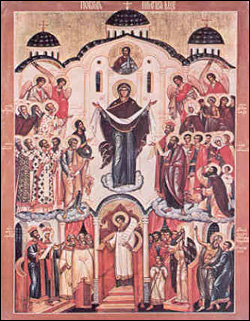
The Queen of Heaven granted victory to the Byzantine Emperors in battle, and for this reason they had the habit of taking along Her icon into battle. She fortified the ascetics and the fervent adepts of Christian life in their struggle against human passions and frailties. She enlightened and instructed the Church fathers and teachers, including St. Cyril of Alexandria himself, when he vacillated on whether to acknowledge the innocence and holiness of St. John Chrysostome.
The Holy Virgin placed hymns into the mouths of the composers of various church chants, sometimes creating famous singers out of those who were incapable or had no talent for singing, but were pious church laborers, such as St. Romanus the Melodist. It is not surprising, therefore, that Christians tried to magnify the name of their customary Protectress. Feast days were established in Her honor, wondrous hymns were dedicated to Her, and Her images were venerated.
The wrath of the “prince of darkness” provoked the “sons of apostasy” to once again rise up against Emmanuel and His mother in that very Constantinople which now venerated the Mother of God as its Intercessor, just as Ephesus used to do. Unable at first to speak out openly against the Champion Leader, they wished to diminish Her glorification by forbidding the veneration of Christ and His saints, calling it idolatry. Here, too, the Mother of God supported the adepts of piety in their struggle for the veneration of icons, manifesting a multitude of miracles from Her icons and healing the chopped off hand of St. John Damascene, who had written in support of icons.
The persecution of worshippers of icons and saints once again ended with the victory and the triumph of Orthodoxy, for the veneration accorded to icons ascends to those who are depicted in them; and God’s saints are honored as friends of God for the sake of the grace of God that dwells within them, according to the psalm: “Thy friends are exceedingly precious to me, Lord.” Special honor in heaven and on earth has been accorded to the Holy Mother of God, Who even in the days of the icons’ desecration manifested so many wondrous miracles through them, that even now we lovingly remember them. The hymn: “All creation rejoices in Thee, O Grace-filled One” and the icon of the Mother of God of the Three Hands remind us of the healing of St. John Damascene in front of this icon; the image of the Iveron Mother of God reminds us of the miraculous deliverance of this icon from the enemies, after it was thrown into the sea by a widow who was unable to protect it.
None of the persecutions of those who venerate the Mother of God and all that is related to Her memory were able to diminish the love of Christians for the Intercessor. A rule was established, whereby each series of church hymns ends with a hymn in honor of the Theotokos. Many times throughout the year Christians in all corners of the world gather together in church, in order to laud Her, thank Her for assistance received, and ask for Her intercession.
But could the Christians’ enemy the devil, who “as a roaring lion, walketh about, seeking whom he may devour” (1 Peter 5:8), remain an indifferent observer of the glory of the Most-honorable Theotokos? Could he acknowledge his defeat and cease battling against truth through the people who do his will? And thus, when the entire universe was filled with the glad tidings of the Christian faith, when the name of the Most-holy Mother of God was being called upon everywhere, when the world became filled with Her churches, while the homes of Christians became adorned with Her icons, then a new heresy in regard to the Mother of God appeared and was disseminated. This heresy is dangerous primarily because many people are unable to understand right way the extent to which it undermines genuine veneration of the Mother of God.
(To be continued)
Saint John of San Francisco

THE ROYAL WAY

To be so meek as to descend
From throne and in the cellar of death to end —
So thus begins the “royal way” for each
Of us for the kingdom of God to reach
And for this earthly kingdom to forsake.
There is no other way for us to take,
But the shortest path
Of the meekest Tsar!
Seeing the future in what came before,
When dead was Russia and the Tsar was slain,
Seeing that neither we may yet restore,
Let us be meek… God’s wisdom will decide
What was in vain and what was not in vain.
Let us be meek and in God’s love abide.
Let us be meek, so that the people are
Once more made worthy of their Tsar,
And Russia is restored to them again.
— I. Grachev
Translated by Kosara Gavrilovic
|
|